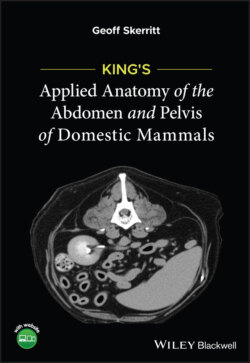Читать книгу King's Applied Anatomy of the Abdomen and Pelvis of Domestic Mammals - Geoff Skerritt - Страница 41
2.3 Regions of the Alimentary Tract (Figure 2.1)
ОглавлениеFigure 2.1 The general arrangement of the intestines of the domestic mammals. The diagrams of the mammalian gastrointestinal tracts are drawn from the dorsal view although the ruminant intestinal spiral and the abomasum are displaced to the right by the rumen. The duodenum is V‐shaped with the ascending limb lying dorsally on the right at the level of the base of the caecum (mauve). The stomach and the duodenum are both coloured green on the diagram. The jejunoileum is not shown on the diagram but occupies a large space between the duodenum and the colon mainly on the right. The transverse and descending colon retain their basic position. The transverse colon passes cranial to the root of the mesentery which contains the cranial mesenteric artery (red circle).
In the higher vertebrates the regions of the tract comprise the oesophagus, stomach, small intestine, large intestine and rectum. In ruminant herbivores (e.g. the ox) the stomach is very large and divided into four distinct regions, each with its own structure and function (see Sections 4.1 and 4.2.). The small intestine comprises the duodenum, jejunum and ileum (although these two divisions are ill‐defined and are termed the jejunoileum). The large intestine in most species comprises a fairly long portion known as the colon, with a relatively short blind‐ending diverticulum known as the caecum. However, there are wide species variations, and in some herbivores (e.g. the horse), the caecum is very large (see Section 6.2.1).
In lower vertebrates marked variations from the above pattern occur. For example, in several varieties of fish no stomach is present, there being only a single tube between the pharynx and the intestine, which may be regarded as equivalent to the oesophagus. In fact the oesophagus only becomes well defined structurally in land vertebrates with the development away from gill breathing, i.e. an adaptation for the extraction of oxygen from water.
Important variations occur also in connection with the modifications to increase surface area mentioned earlier. Of particular importance, in view of its obvious functional success, is the so‐called spiral intestine that characterises elasmobranch fishes. In these species the intestine is cigar‐shaped and has a fold of internal epithelium projecting into the lumen. This projection twists spirally along the length of the intestine, thereby increasing the internal surface area. However, it seems that this adaptation is less successful than the greatly elongated intestine that is found in higher forms, from the teleost fishes to land vertebrates.
One feature that is common to the digestive tract of all vertebrates is the presence of a constriction known as the pylorus, which in most species occurs at the distal end of the stomach where the latter is continuous with the small intestine. The pylorus is a point of demarcation; that part of the tract cranial to the pylorus is known as the foregut and the region caudal to it is the hindgut. Primitively therefore the foregut was merely a short link between the pharynx and the intestine, with the latter being solely responsible for chemical treatment and absorption, but in higher orders the stomach has taken on an important role in this connection. It has developed as a storage area and for both the physical and chemical treatment of food. It seems likely that the development of this organ in an evolutionary sense is related to changed feeding habits, developing from primitive food strainers.
